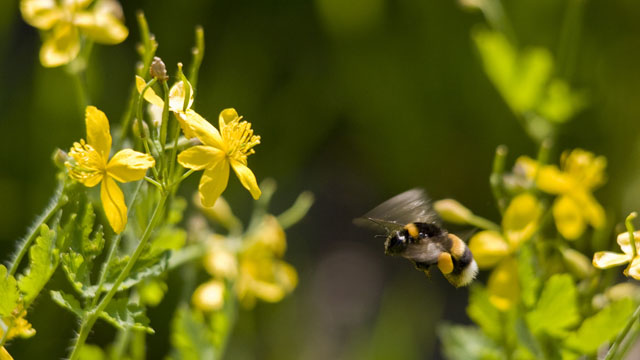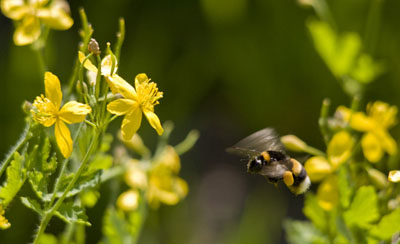Attract bumblebees to your garden
Planting appropriately means gardeners can do much to attract bumblebees


Most gardens can boast about six species of bumblebee; my own (he says, with the merest hint of pride) hosts eight species: the common carder, red-tailed, garden, white-tailed, early and buff-tailed, as well as two species of cuckoo bumblebee. Did you know that there are bees that lay their eggs in other bees' nests? I certainly didn't, until the wild-bee enthusiast Kate Bradbury came and ‘bee-watched' in my garden to tally up my brood.
The greatest cause of decline in the UK bumblebee population is the destruction of habitat. This can come about as a result of building development on land that was hitherto hospitable to insect life, the change of use of land or chemical pollution-all of them detrimental to the life-cycle of a much-loved but rather neglected member of the family Hymenoptera, which also includes wasps and ants.
At least, gardeners can do our bit to create patches of land that are beneficial to bumblebees' wellbeing. We're frequently treated to tales of doom and gloom as to the losses of wildlife on our planet and with good reason, as wake-up calls are needed if we're not to find that something has disappeared without our noticing. But, all too often, we're left thinking that we can do little to improve matters, which is often far from the truth.
In my experience, all forms of wildlife are opportunists. It's in their interest (indeed, it's instinctive) to survive given the smallest form of encouragement. With thoughtful gardening, we can help bumblebees in their quest for survival in exactly the same way that we helped frogs and toads-the garden pond was instrumental in saving them from near oblivion when building sites replaced village greens across the land.
Aiding bumblebee survival isn't necessary simply from a sentimental point of view. Bees pollinate about a third of our food crops; without them, it's no exaggeration to say that the world would starve and, yet, few of us are aware of the vital role they play in feeding us, from ensuring the production of apples, pears and plums to peas and beans. Even cabbages, carrots and onions would not exist without the pollinating efforts of bees, for without the seeds that are produced thanks to their floral fertilisation, what could we sow?
The reason my own garden is so rich in bees is down to two main factors: we run an organic regime here and, for the past 25 years or so, I've used no chemical sprays whatsoever plus I plant lots of nectar- and pollen-rich flowers. This doesn't mean that I have a garden devoid of showy double flowers, whose vital central stigma and stamens have been replaced or overwhelmed by petals-it's just that I make sure I have plenty of other flowers that do offer the bees what they need.

Most important of all is our two-acre wildflower meadow behind the barn where I write. It was sown about six years ago, with Emorsgate's wildflower seeds (01553 829028; www.wildseed.co.uk); the company makes a mixture specially developed for chalk downland like ours. I sowed the seed in autumn (the best time for those seeds that need to be repeatedly frozen and thawed to trigger germination) and, each year, it's altered slightly in its make-up and the preponderance of particular species.
Sign up for the Country Life Newsletter
Exquisite houses, the beauty of Nature, and how to get the most from your life, straight to your inbox.
In April, we're awash with cowslips, to be followed by vetches, clover, marguerites, field scabious and knapweed. A healthy sprinkling of the semi-parasitic yellow rattle (Rhinanthus minor) has helped to reduce the vigour of the grasses on what was once a richly fertilised farmer's field.
Over the summer, we mow rides through the wildflowers, then, once a year-in September, when the seed has fallen-it's cut and the hay removed. That really is all there is to it. My reward is a meadow that gives me more pleasure than I can express and which allows me to boast of a bumblebee count to impress my neighbours. I can only hope that they take the hint.
* Follow Country Life on Twitter
Country Life is unlike any other magazine: the only glossy weekly on the newsstand and the only magazine that has been guest-edited by HRH The King not once, but twice. It is a celebration of modern rural life and all its diverse joys and pleasures — that was first published in Queen Victoria's Diamond Jubilee year. Our eclectic mixture of witty and informative content — from the most up-to-date property news and commentary and a coveted glimpse inside some of the UK's best houses and gardens, to gardening, the arts and interior design, written by experts in their field — still cannot be found in print or online, anywhere else.
-
 About time: The fastest and slowest moving housing markets revealed
About time: The fastest and slowest moving housing markets revealedNew research by Zoopla has shown where it's easy to sell and where it will take quite a while to find a buyer.
By Annabel Dixon
-
 Betty is the first dog to scale all of Scotland’s hundreds of mountains and hills
Betty is the first dog to scale all of Scotland’s hundreds of mountains and hillsFewer than 100 people have ever completed Betty's ‘full house’ of Scottish summits — and she was fuelled by more than 800 hard boiled eggs.
By Annunciata Elwes